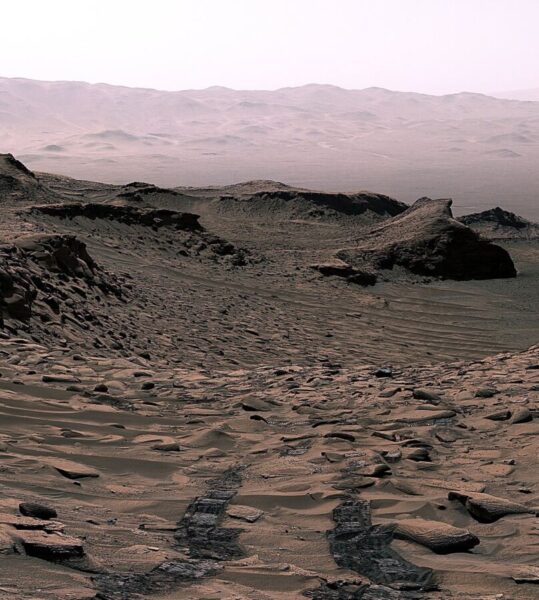Hidden beneath the dusty surface of Mars, NASA’s Curiosity rover has discovered compelling evidence that a carbon cycle once operated on the Red Planet, potentially solving one of the greatest mysteries about Mars’ past atmosphere.
The finding, published in the April 17, 2025 issue of Science, reveals significant deposits of siderite—an iron carbonate mineral—in three drill samples taken from Mount Sharp in Mars’ Gale Crater. This discovery may explain what happened to the carbon dioxide that once made Mars’ atmosphere thick enough to support flowing water.
“The discovery of abundant siderite in Gale Crater represents both a surprising and important breakthrough in our understanding of the geologic and atmospheric evolution of Mars,” said Benjamin Tutolo, assistant professor at the University of Calgary and lead author of the study.
Scientists have long theorized that Mars once had a dense CO2-rich atmosphere and surface water, which should have interacted with the planet’s rocks to form carbonate minerals. However, previous rover missions and satellite observations hadn’t detected the predicted quantities, leading to what researchers called the “missing carbonate” mystery.
Using the rover’s Chemistry and Mineralogy (CheMin) instrument, which analyzes powdered rock samples using X-ray diffraction, researchers found siderite at concentrations between 4.8% and 10.5% by weight in three samples taken from different elevations as Curiosity climbed Mount Sharp.
“Drilling through the layered Martian surface is like going through a history book,” explained Thomas Bristow, research scientist at NASA Ames and co-author of the paper. “Just a few centimeters down gives us a good idea of the minerals that formed at or close to the surface around 3.5 billion years ago.”
What makes this discovery particularly significant is evidence of a partially closed carbon cycle. In some samples, researchers found iron oxyhydroxides—minerals that form when siderite breaks down—indicating that some of the sequestered carbon dioxide was later released back into the atmosphere.
The presence of siderite alongside magnesium and calcium sulfates in these layers suggests that evaporation played a key role. As ancient wetlands dried up, waters became increasingly concentrated, triggering mineral precipitation. This pattern of minerals tells researchers about changes in the Martian environment, revealing how the planet transitioned from wetter to drier conditions.
If similar carbonate deposits exist in other sulfate-rich regions across Mars, they could represent a substantial reservoir of ancient atmospheric carbon dioxide—potentially equivalent to 2.6 to 36 millibars of atmospheric pressure. For comparison, Mars’ current atmosphere contains only about 6 millibars of CO2.
The discovery helps resolve how Mars lost its warmer, wetter conditions. Some carbon dioxide escaped to space, while significant amounts were locked away in minerals beneath the surface. Unlike Earth’s balanced carbon cycle, Mars’ cycle eventually became one-directional, sequestering more carbon than it released.
This finding also demonstrates why orbital instruments may not have detected these carbonates earlier—they could be masked by other minerals or hidden beneath the surface, requiring direct sampling to reveal their presence.
As Curiosity continues its journey up Mount Sharp, researchers hope to uncover more evidence about Mars’ ancient climate and the processes that transformed it into the cold, dry world we see today.
If our reporting has informed or inspired you, please consider making a donation. Every contribution, no matter the size, empowers us to continue delivering accurate, engaging, and trustworthy science and medical news. Independent journalism requires time, effort, and resources—your support ensures we can keep uncovering the stories that matter most to you.
Join us in making knowledge accessible and impactful. Thank you for standing with us!

